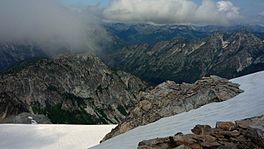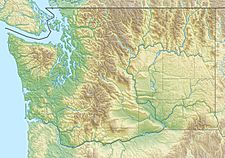Sandalee Glacier facts for kids
Quick facts for kids Sandalee Glacier |
|
|---|---|

Portions of the Sandalee Glacier
|
|
| Type | Cirque glacier |
| Location | Chelan County, Washington, U.S. |
| Coordinates | 48°24′31″N 120°47′18″W / 48.40861°N 120.78833°W |
| Length | .45 mi (0.72 km) |
| Terminus | Barren rock |
| Status | Retreating |
Sandalee Glacier is a cool natural ice formation. It is found in the North Cascades National Park and the Lake Chelan National Recreation Area. These places are in the state of Washington in the U.S.. The glacier sits on the north and east sides of McGregor Mountain.
Contents
What is Sandalee Glacier?
Sandalee Glacier is a type of ice called a cirque glacier. This means it forms in a bowl-shaped hollow on the side of a mountain. Think of it like a giant scoop taken out of the mountain. Snow builds up in this scoop over many years. The snow gets packed down and turns into ice.
Where is it Located?
This glacier is high up in the mountains. It starts at about 7,800 feet (2,377 meters) above sea level. It then stretches down to about 6,800 feet (2,073 meters). That's a drop of 1,000 feet! The glacier itself is about 1.5 miles (2.4 kilometers) long. It's a big piece of ice on the mountain.
Why Glaciers are Important
Glaciers are like giant frozen rivers. They are important because they store a lot of fresh water. When glaciers melt slowly, they provide water to rivers and streams. This water is used by plants, animals, and even people.
How Glaciers Change
Glaciers are always moving, but very slowly. They can also grow bigger or shrink smaller. When a glacier gets smaller, it is called retreating. This means the ice is melting faster than new snow is falling and turning into ice. Sandalee Glacier is currently retreating. This means it is getting smaller over time.
Studying Sandalee Glacier
The National Park Service is a group that takes care of national parks. They are studying Sandalee Glacier right now. They want to learn how glaciers are changing. This helps them understand how the climate is affecting our planet. By watching glaciers like Sandalee, scientists can see how much ice is melting each year. This information is important for understanding our environment.


